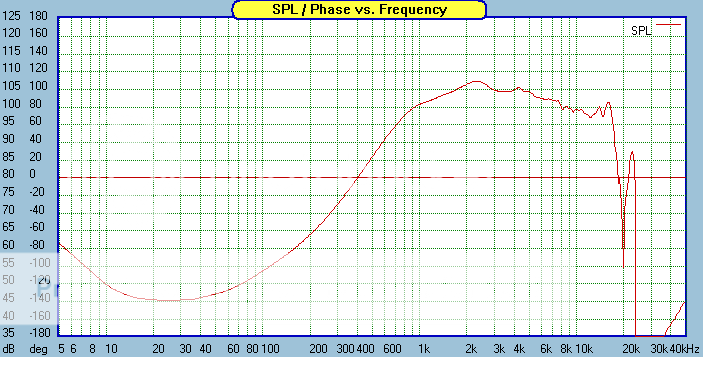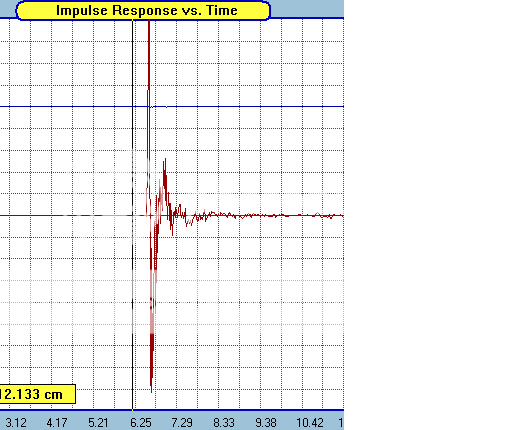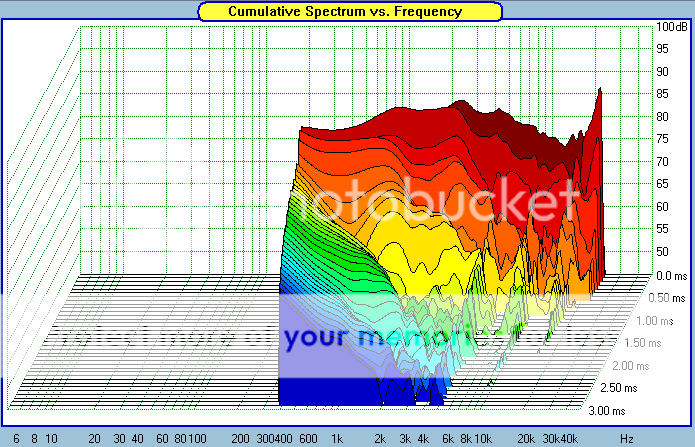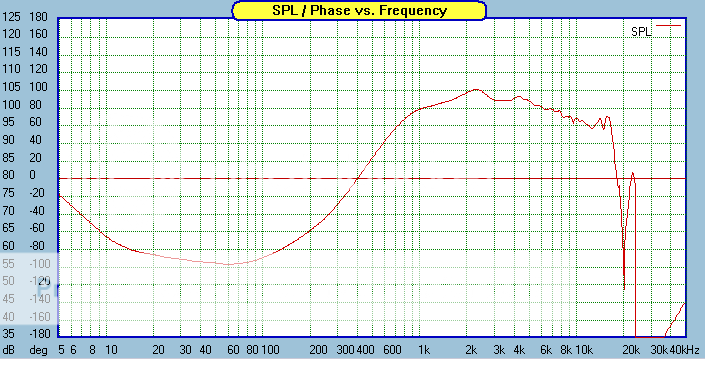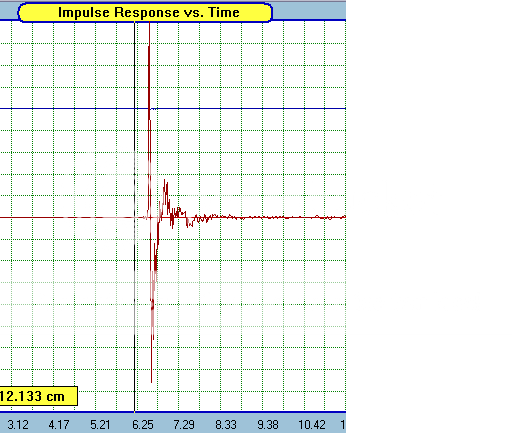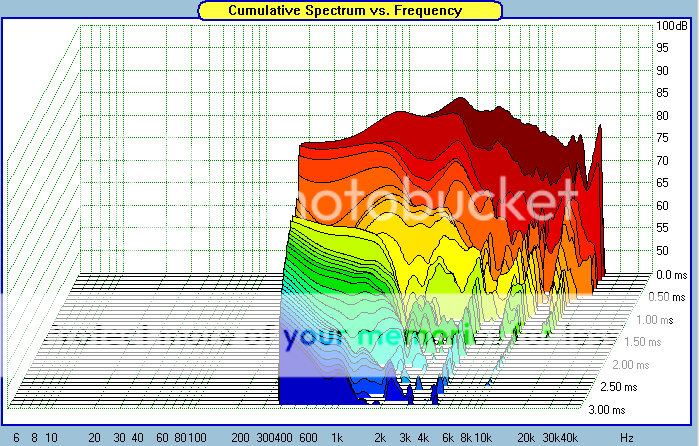CLS said:
Alas!
I got some custombuilt phase plugs for my 18" woofers:
The de-cap'ed woofers sounded fine without the plugs, just uglier. It'll be a disaster if the plugs make them sound worse
Those are good looking plugs. As long as the plug is straight for the entire xmax of the cone you will be fine. Our Apollo driver was xmaxing to the point where the curved part of the plug was too near the base of the cone. The longer the plug the better usually.
nickmckinney said:
Those are good looking plugs. As long as the plug is straight for the entire xmax of the cone you will be fine....
Thanks a lot for the kind words and experience sharing.
The straight part of my plugs cover the whole Xmax (which is small) and with extra several mm to spare.
Any interest in testing an older driver?
Specifically JBL 123A. This is the woofer used in the L100. I have a pair I could send along. This is a spectacularly good woofer to my ears, with extended range and quite deep bass. (25Hz Fs and .5Qts)
Might be an interesting point of comparison, and potentially validate the theory that higher harmonics are better suppressed by AlNiCo.
If you're interested, PM me with your test terms and I'll get a pair out to you.
Specifically JBL 123A. This is the woofer used in the L100. I have a pair I could send along. This is a spectacularly good woofer to my ears, with extended range and quite deep bass. (25Hz Fs and .5Qts)
Might be an interesting point of comparison, and potentially validate the theory that higher harmonics are better suppressed by AlNiCo.
If you're interested, PM me with your test terms and I'll get a pair out to you.
badman said:Any interest in testing an older driver?
I was thinking the same thing. But I had in mind an Altec 806A. Some older, well known drivers might make for an interesting comparison - datapoint.
EDIT: Oh, and by the way. B&C's datasheet shows a much flatter response than your measurement on the QSC horn. Your measurement falls like I would expect, theirs doesn't. Do you know why? They don't seem to say what horn was used to get the flat graph.
panomaniac said:
I was thinking the same thing. But I had in mind an Altec 806A. Some older, well known drivers might make for an interesting comparison - datapoint.
YEAH!
[Nobody believes me.
panomaniac said:
EDIT: Oh, and by the way. B&C's datasheet shows a much flatter response than your measurement on the QSC horn. Your measurement falls like I would expect, theirs doesn't. Do you know why? They don't seem to say what horn was used to get the flat graph.
It's the appropiate question; manufacturers often show drivers' performance on exponential horns for the flattest curves. The only way to compare apples to apples is via data measured on a Plane Wave Tube (PWT).
In theory, a true CD horn/waveguide w/o EQ will mimick PWT performance, but....
panomaniac said:EDIT: Oh, and by the way. B&C's datasheet shows a much flatter response than your measurement on the QSC horn. Your measurement falls like I would expect, theirs doesn't. Do you know why?
They probably took more than 2 minutes to develop the EQ
Hmmmm that hardly seems fair, to post an EQ'd plot. At least not without saying so. And at least you say that you do EQ to get things near flat.
I'd rather just see the response with no EQ, so that I know what kind of work the driver needs. Won't look as pretty, but at least it's the good old "level playing field."
I'd rather just see the response with no EQ, so that I know what kind of work the driver needs. Won't look as pretty, but at least it's the good old "level playing field."
The frequency response measurement of the B&C drivers is without any EQ. But they measure their drivers on a ME45 Horn, the Me45 is not a CD-Horn!panomaniac said:Hmmmm that hardly seems fair, to post an EQ'd plot.
panomaniac said:Hmmmm that hardly seems fair, to post an EQ'd plot. At least not without saying so. And at least you say that you do EQ to get things near flat.
I'd rather just see the response with no EQ, so that I know what kind of work the driver needs. Won't look as pretty, but at least it's the good old "level playing field."
I will be including one un-EQ'ed on axis plot for all of the horns this weekend so people have an idea what the raw response is. Really though there is not much difference other than the low end rolloff. I'm not trying to smooth the response, just tilt it so it is fairly flat in its passband.
jogi59 said:
The frequency response measurement of the B&C drivers is without any EQ. But they measure their drivers on a ME45 Horn, the Me45 is not a CD-Horn!
That's right it's the ME45. I wonder why they removed all that info fromt eh spec sheets, I'm sure it was there last time I looked.
Brandon,
- ( Big ) Thanks ! for your efforts on measuring ( & posting the results ) for some of the more commonly used drivers talked up on the various sites .
- As long as you continue to post nearfield measurements , as well as distortion measurements I'll get useful data .
- Here's a pic ( actually a collage made using your data ) of the GPA 414 . This was "assembled" using "Paint" & "PowerPoint" .
- This is the size of pic I like to view using a 40 - 50 db vertical scale. It does offer better resolution .

>< cheers
ps; I don't find your "gated/MLS" results very worthwhile since it is obvious to my eyes that they have a lot of smoothing below 1K ( regardless of the formulas ) .
- ( Big ) Thanks ! for your efforts on measuring ( & posting the results ) for some of the more commonly used drivers talked up on the various sites .
- As long as you continue to post nearfield measurements , as well as distortion measurements I'll get useful data .
- Here's a pic ( actually a collage made using your data ) of the GPA 414 . This was "assembled" using "Paint" & "PowerPoint" .
- This is the size of pic I like to view using a 40 - 50 db vertical scale. It does offer better resolution .

>< cheers
ps; I don't find your "gated/MLS" results very worthwhile since it is obvious to my eyes that they have a lot of smoothing below 1K ( regardless of the formulas ) .
EarlK said:ps; I don't find your "gated/MLS" results very worthwhile since it is obvious to my eyes that they have a lot of smoothing below 1K ( regardless of the formulas ) .
The gate does introduce a smoothing type effect for the typical gates diy'ers must use. So yeah, that's why nearfields are useful for <1khz. Above that though I think the gated farfield are more accurate.
The below occurred OT in a thread at AVS; I thought I'd include it here for those interested.
********************************************************
Me: So you tested the QSC w/the foam and found it to be better? What about the XT1086?
augerpro: You know I did the comparison on your XT1086 with foam and haven't really looked at the data yet as I've been so busy. I was going to post some of it and couldn't find some measurements so I think I may have forgot to save some of the data. I probably won't have time to re-measure either. BUT I did do a quick comparison while I was doing tha actual measurements and with foam it was smoother and flatter. I didn't compare IR or CSD but I do remember thinking the improvement was very significant for frequency response. I expect that the IR and CSD would show an improvement also.
The improvement for the QSC wasn't quite as pronounced. I'm hesitant to make much more of a judgement on the comapison until I get a chance to look more closely at the data. But I can say you should definitly try the 1086 with the foam. I should have it in the mail back to you soon.
penngray: Yeah but how did it sound?
Augerpro: Didn't get a chance to do that either
Me: "BUT I did do a quick comparison while I was doing tha actual measurements and with foam it was smoother and flatter. "
Great!
So if you didn't listen do you mean you saw the plots in real time while measuring?
By smoother do you mean the whole response in general and/or the top octave suckout in particular?
Augerpro: Yeah just after I had finished the last measurement I plotted the before and after responses. But I must not have saved the before impulse responses because later when I went to replot everything to make screenshots for the my website I could not find them. But what I remember was the response smoothed out above 8khz and the midband hump from 3khz to 8khz had flattened. Kind of strange really since the foam in the QSC just resulted in a 3 dB drop evenly above 2khz or so. But on the 1086 it was like 3dB for the midband and a bit less above and below, so the overall response was flattened. I'll try to look back through my data and see what I can find to post.
******************************************************
********************************************************
Me: So you tested the QSC w/the foam and found it to be better? What about the XT1086?
augerpro: You know I did the comparison on your XT1086 with foam and haven't really looked at the data yet as I've been so busy. I was going to post some of it and couldn't find some measurements so I think I may have forgot to save some of the data. I probably won't have time to re-measure either. BUT I did do a quick comparison while I was doing tha actual measurements and with foam it was smoother and flatter. I didn't compare IR or CSD but I do remember thinking the improvement was very significant for frequency response. I expect that the IR and CSD would show an improvement also.
The improvement for the QSC wasn't quite as pronounced. I'm hesitant to make much more of a judgement on the comapison until I get a chance to look more closely at the data. But I can say you should definitly try the 1086 with the foam. I should have it in the mail back to you soon.
penngray: Yeah but how did it sound?
Augerpro: Didn't get a chance to do that either
Me: "BUT I did do a quick comparison while I was doing tha actual measurements and with foam it was smoother and flatter. "
Great!
So if you didn't listen do you mean you saw the plots in real time while measuring?
By smoother do you mean the whole response in general and/or the top octave suckout in particular?
Augerpro: Yeah just after I had finished the last measurement I plotted the before and after responses. But I must not have saved the before impulse responses because later when I went to replot everything to make screenshots for the my website I could not find them. But what I remember was the response smoothed out above 8khz and the midband hump from 3khz to 8khz had flattened. Kind of strange really since the foam in the QSC just resulted in a 3 dB drop evenly above 2khz or so. But on the 1086 it was like 3dB for the midband and a bit less above and below, so the overall response was flattened. I'll try to look back through my data and see what I can find to post.
******************************************************
- Status
- This old topic is closed. If you want to reopen this topic, contact a moderator using the "Report Post" button.
- Home
- Loudspeakers
- Multi-Way
- Driver testing results
